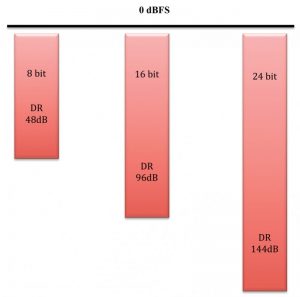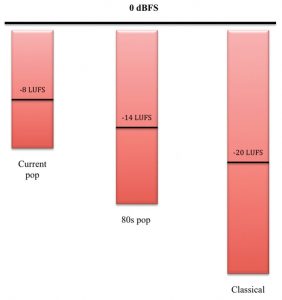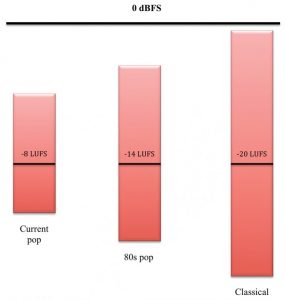Tutors’ Tutorials: WTF is LUFS FFS?!
Tutors’ Tutorials: WTF is LUFS FFS?!
The increase in bit depth causes the range of the scale to be extended downwards allowing softer sounds to be captured authentically, however the maximum digital level representing the loudest sounds is the same for any bit depth and is known as 0dBFS referenced to digital Full Scale. 0dBFS has remained the highest, absolute level at which audio can be coded.
 But exactly how loud is 0dBFS? Curiously enough, even though it uses a decibel scale, which is closely associated with amplitude measurements in the analogue domain, the dBFS scale doesn’t measure loudness, it merely indicates how much room the signal has before digital distortion.
But exactly how loud is 0dBFS? Curiously enough, even though it uses a decibel scale, which is closely associated with amplitude measurements in the analogue domain, the dBFS scale doesn’t measure loudness, it merely indicates how much room the signal has before digital distortion.
Ultimately how loud a signal is depends on the position of the volume dial of your monitoring system. This means that there is no standard way of measuring loudness in the digital domain, which has been a recurring problem in audio and broadcast industries for close to two decades.
The problem lies in the fact that up until very recently we have been using the peak level of audio signals as the main level criterion in many audio industry applications. The peak level tells us very little about the perceived loudness of the track, this can be closer approximated by the RMS measurement of the track. This would be like comparing the height of the mast (peak level) to the weight of the ship (RMS level). But unfortunately, there is no such standard for an RMS scale.
Over the years, several attempts have been made to create a standard way of measuring loudness in the digital domain based on the RMS values but it wasn’t until the 2006 paper published by the International Telecommunications Union (ITU) entitled Algorithms to Measure Audio Programme Loudness and True-peak Audio Level, commonly known in audio geek circles as ITU-R BS.1770, that a real possibility of a solution appeared on the proverbial horizon.
Among other things, this paper identified that “listeners desire the subjective loudness of audio programmes to be uniform for different sources and programme types.” And that, “it is essential to have a single recommended algorithm for objective estimation of subjective loudness.” On the technical side, the paper made an observation that existing metering technologies do not adequately measure loudness or the true-peak level contained in a digital signal.
 It drew the attention of the European Broadcast Union (EBU) which, after several revisions by ITU, released their own publication in 2011 entitled Loudness Normalisation And Permitted Maximum Level Of Audio Signals. Commonly known as simply R128, this paper introduces a new unit of measurement called LU (Loudness Unit) or more accurately LUFS (Loudness Unit referenced to digital Full Scale). The unit employs clever psychoacoustic filtration techniques to approximate how humans perceive loudness. The result is a unit that is very similar to RMS but is more intelligent as it authentically models the human loudness perception.
It drew the attention of the European Broadcast Union (EBU) which, after several revisions by ITU, released their own publication in 2011 entitled Loudness Normalisation And Permitted Maximum Level Of Audio Signals. Commonly known as simply R128, this paper introduces a new unit of measurement called LU (Loudness Unit) or more accurately LUFS (Loudness Unit referenced to digital Full Scale). The unit employs clever psychoacoustic filtration techniques to approximate how humans perceive loudness. The result is a unit that is very similar to RMS but is more intelligent as it authentically models the human loudness perception.
EBU R128 recommends that the programme loudness level shall be normalised to a target level of -23.0 LUFS. Meaning that we can now use the perceived loudness as the main criterion of level measurement rather than the peak level.
The usage of LUFS has been adopted by all major broadcasters in Europe and recently the United States passed the so-called CALM Act demanding US broadcasters to comply with a very similar standard. Some DAWs such as Steinberg’s Wavelab 8 now come standard with LUFS meters and many third party plug-in manufacturers are releasing a good selection of meters that include the LUFS scale.
 All this should spell the end of the loudness war. By playing back all audio at around the same loudness there will no longer be a motivation to master music or adverts too loudly at the expense of the dynamic range because the average over-compressed casualty of the loudness war track will not sound very good when played next to fully dynamic pieces of similar loudness.
All this should spell the end of the loudness war. By playing back all audio at around the same loudness there will no longer be a motivation to master music or adverts too loudly at the expense of the dynamic range because the average over-compressed casualty of the loudness war track will not sound very good when played next to fully dynamic pieces of similar loudness.
Audio that on average exceeds -23 LUFS will be turned down during playback to match the new standard playback level and audio that is below -23 LUFS will be turned up. This has far reaching consequences and hopefully in the years to come we will regard the last 20 years as that crazy time when loudness was unregulated and louder always meant better.
David Chechelashvili is a tutor at SAE Institute and a studio and mastering engineer. In his spare time he composes ambient music and collects Waldorf synthesisers. He can be contacted at d.chechelashvili@sae.edu
